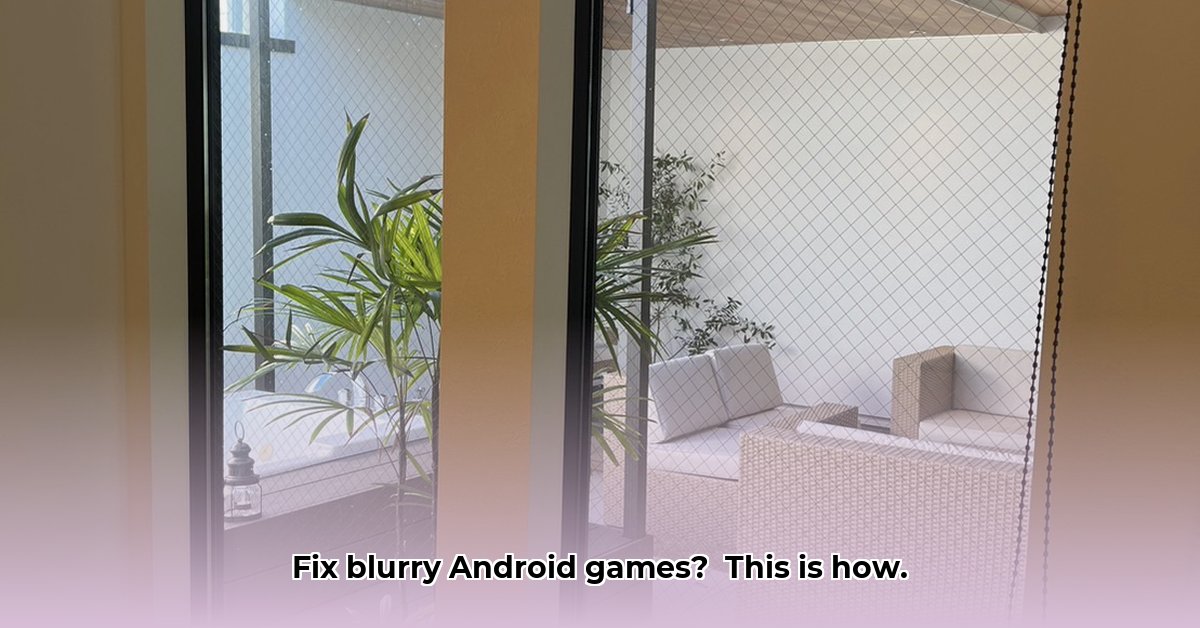Is your favorite Android game looking blurry, stretched, or just plain off? Don’t worry, you’re not alone! This comprehensive guide will walk you through a range of solutions to get your games looking crisp and clear, covering everything from simple in-game tweaks to more advanced system-level adjustments. Get ready to maximize your mobile gaming experience!
Understanding the Problem: Why Does This Happen?
Before we dive into the fixes, let’s understand why Android game resolution issues arise in the first place. Several factors can contribute:
- Mismatched Resolutions: Games are designed to run at specific resolutions. If the game’s resolution doesn’t perfectly match your device’s screen resolution, you might see stretching, blurring, or black bars.
- Aspect Ratio Conflicts: Aspect ratio is the proportional relationship between the width and height of the display. If the game’s aspect ratio doesn’t match your phone’s, you’ll often see black bars on the sides (pillarboxing) or the top and bottom (letterboxing).
- Device Limitations: Older or less powerful Android devices might struggle to render games at higher resolutions, leading to performance issues and a blurry appearance.
- Game Optimization: Some games are simply poorly optimized, meaning they don’t scale well to different screen sizes or resolutions.
- Software Glitches: Bugs in the game itself or in your Android operating system can sometimes cause resolution problems.
Method 1: Tweak the In-Game Settings First
The easiest and often most effective solution is to adjust the game’s graphics settings directly. Most games offer some level of control over resolution, texture quality, and other visual parameters.
Steps:
- Launch the game.
- Look for a “Settings,” “Options,” or “Graphics” menu. This is usually represented by a gear icon (⚙️), three dots (…), or a similar symbol.
- Search for resolution settings. These might be labeled “Resolution,” “Display Resolution,” “Screen Resolution,” “Graphics Quality,” or something similar.
- Experiment with different settings. Try increasing the resolution or graphics quality for sharper visuals. Be aware that higher settings can sometimes slow down the game, especially on older devices. Find the sweet spot between visual fidelity and smooth gameplay.
- Apply the changes and restart the game (if prompted).
Method 2: Adjust Your Android’s Display Settings
If tweaking the in-game settings doesn’t solve the problem, you can try adjusting your Android device’s display settings. Keep in mind that these settings will affect everything on your phone, not just your games.
Steps:
- Open your phone’s Settings app.
- Find the “Display” section. The exact wording may vary depending on your Android version and device manufacturer.
- Look for “Screen Resolution,” “Display Resolution,” or a similar option.
- Choose a different resolution. If you have multiple games with different resolution needs, you may need to compromise or adjust settings on a game-by-game basis.
- Adjust display size or font size (optional). These settings can sometimes indirectly improve a game’s display.
Method 3: Force Fullscreen Mode
Some games don’t automatically use the entire screen area, resulting in black bars or a small display. You can try forcing fullscreen mode to make the game fill the entire screen.
Steps:
- Open your phone’s Settings app.
- Find the “Display” section.
- Look for “Full Screen Apps” or something similar. The specific name can vary depending on your device.
- Select the game you’re having trouble with.
- Enable the setting to force the game to use the full screen.
Method 4: Clear the Game’s Cache and Data
Sometimes, corrupted temporary files can cause graphic problems. Clearing the game’s cache and data can often resolve these issues.
Steps:
- Open your phone’s Settings app.
- Find “Apps” or “Applications.”
- Locate the game in the app list.
- Tap the game, then tap “Storage.”
- Tap “Clear Cache” and “Clear Data.” Note: Clearing data will delete your game progress, so only do this if you’re willing to start over or if your game has cloud saving enabled.
Method 5: Update Everything
Make sure both your Android operating system and the game itself are up-to-date. Updates often include bug fixes and performance improvements that might resolve your resolution issue.
Steps:
- Open the Google Play Store app.
- Tap your profile icon in the top right corner.
- Tap “Manage apps & device.”
- Tap “Updates available” to see if there are any updates for your games or Android system.
- Update everything that needs updating.
Method 6: Explore Developer Options (Advanced Users Only!)
Android’s Developer Options menu provides access to advanced settings that can sometimes help with resolution problems. Be warned: Changing settings in Developer Options without understanding what they do can cause instability or other issues with your phone.
Enabling Developer Options:
- Open your phone’s Settings app.
- Scroll down and tap “About phone.”
- Find the “Build number” and tap it seven times.
- You should see a message saying “You are now a developer!”
Adjusting Settings (Use with Caution!):
- Go back to the main Settings menu and look for “Developer options.”
- Look for settings like “Minimum width” or “Smallest width.” This setting adjusts the DPI (dots per inch) of your screen, which can indirectly affect game resolution. Increasing the value makes everything smaller, potentially forcing a game into a higher resolution mode.
- Experiment with different values, but be sure to note the original value so you can revert back if necessary.
Method 7: Third-Party Apps (Use with Extreme Caution!)
There are apps available on the Google Play Store that claim to boost game resolution or improve graphics performance. However, these apps often come with risks, such as malware, system instability, and battery drain. Use them with extreme caution and only after thorough research.
If you choose to use a third-party app:
- Read reviews carefully.
- Check the app’s permissions.
- Monitor your phone’s performance and battery life after installing the app.
- Uninstall the app if you experience any problems.
Troubleshooting Common Issues
Even after trying these methods, you might still face problems. Here are some common issues and potential solutions:
- Black bars on the screen: This is usually caused by an aspect ratio mismatch. Check the game’s settings for aspect ratio options.
- Game looks blurry or pixelated: Try lowering the in-game resolution or adjusting your Android’s DPI settings.
- Game crashes or freezes frequently: Try lowering the game’s graphics settings or closing background apps to free up resources.
When to Accept Defeat
Sometimes, despite your best efforts, you simply can’t fix a game’s resolution problems. This might be due to:
- Hardware limitations: Your phone might not be powerful enough to run the game at a higher resolution.
- Poor game optimization: The game itself might be poorly optimized for Android devices.
- Unfixable bugs: The game might have bugs that affect resolution that can only be fixed by the developers.
If you’ve tried everything and still can’t get the game to look right, it might be time to accept defeat and move on.
Final Thoughts
Fixing game resolution on Android can be a frustrating process, but with a little patience and experimentation, you can often get your games looking significantly better. Start with the simple solutions and work your way up to the more advanced ones. And remember, always proceed with caution when adjusting system settings or using third-party apps. Happy gaming!
- Call of Duty PC Wont Launch, Just Closes Steam - December 26, 2025
- Why Does CoD Always Fail to Launch? Understanding the Core Issues - December 25, 2025
- Why Call of Duty Not Launching on Steam? Common Technical Reasons - December 24, 2025




